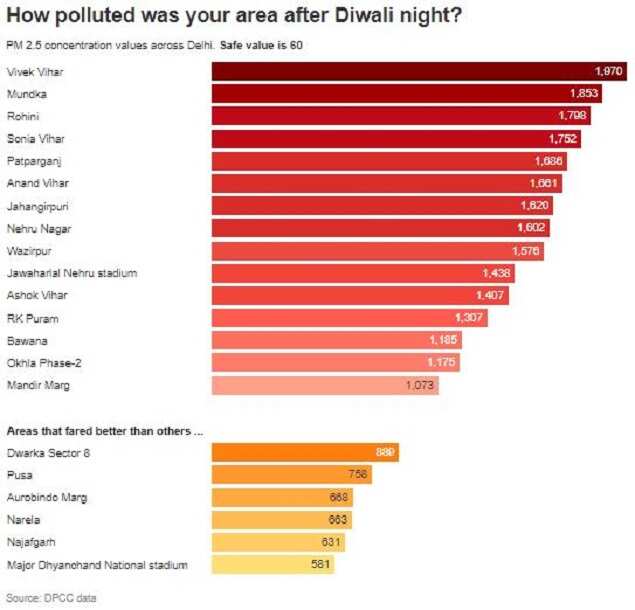
Delhi sets off self-destruct bomb, worst Diwali in 4 years
NEW DELHI: The firecracker ban in Delhi-NCR went up in smoke on Saturday with people flouting it wit..
NEW DELHI: The firecracker ban in Delhi-NCR went up in smoke on Saturday with people flouting it with impunity. While the sound of crackers could be heard during the day, its intensity rose after 6pm and continued well past midnight at some locations.
Track the pollution level in your city
The average hourly PM2.5 concentration in Delhi touched 910 micrograms per cubic metre (g/m3) at midnight, over 15 times the safe standard, before falling due to an increase in wind speed. While the overall Air Quality Index (AQI) touched "severe" on Diwali day with a reading of 414, it was recorded at 435 on Sunday.
In terms of AQI, this was Delhi's worst Diwali since 2016, when a reading of 431 was recorded and 445 the day after, data from both Central Pollution Control Board (CPCB) and System of Air Quality and Weather Forecasting And Research (SAFAR) showed. 
Last year, an AQI of 337 (very poor) was recorded on Diwali day, which marginally rose to 368 (very poor) the next day. A bigger spike was seen in 2018 when AQI rose from 281 (poor) on Diwali day to 390 (very poor) the next day owing to firecrackers.
SAFAR had forecast pollution to touch the "severe" level the day after Diwali even if no firecrackers were burst. It said additional emissions through firecrackers and crop stubble led to hourly PM2.5 concentration crossing more than 1,000 g/m3 at several locations across Delhi.
CPCB data showed that pollution peaked between midnight and 1am. AQI rose gradually from 414 (severe) at 4pm to 446 by 8pm and 460 by 1am. "This year, Diwali was celebrated in mid-November with unfavourable meteorological conditions for dispersal of pollutants compared with 2019 when the festival was in the last week of October," added CPCB.
"The surface temperature was the lowest in the past five years, which might have contributed to more inversion conditions and lowest average mixing height, which limits vertical dispersion. Wind speed on both pre-Diwali and Diwali day were similar. Overall, this Diwali witnessed higher background levels of pollutants and further addition of particulates during night from firecrackers," CPCB stated.
However, a spell of rain through a western disturbance not only helped in settling pollutants, but also increased wind speed in the region allowing air quality to improve on Sunday morning. Delhi's base station, Safdarjung, recorded 0.4mm of rainfall till 5.30pm, while Palam received 1.8mm.
Kuldeep Srivastava, scientist at IMD and head of Regional Weather Forecasting Centre, said, "Easterly winds with speed ranging from 18 to 24 kmph were recorded, which helped in dispersal of pollutants. The rain also helped in settling some pollutants."
LS Kurinji, research analyst at Council on Energy, Environment and Water, said, normally, the impact from firecrackers could hang in the air for several days, but the spell of rain controlled it within hours.
"Air quality stations observed a sharp jump in PM2.5 levels, which rose from 250 g/m3 to over 600 g/m3 on Diwali night. However, on the evening of November 15, light rain accompanied by gusty winds washed out the pollutants and improved the air quality, bringing PM2.5 levels down to 100 g/m3," added Kurinji.
![]()
